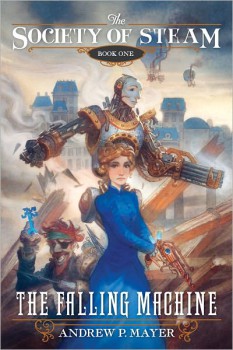Steampunk Spotlight: Society of Steam Trilogy
 Imagine the gilded age… but with superheroes and steampunk technology.
Imagine the gilded age… but with superheroes and steampunk technology.
That is the central premise of Andrew P. Mayer’s Society of Steam trilogy, which just published its final volume in January. The books portray a world in which the brilliant inventor Sir Dennis Darby has brought together heroes to form the Paragons, a New York City group of adventurers that fight menaces to decent society. Among the heroes is the Automaton, an intelligent steam-powered construct of Darby’s own invention.
This alone would be enough of a premise for a trilogy of novels, but the first book in the trilogy, The Falling Machine (Amazon, B&N), begins by throwing this fascinating world into turmoil… by killing off Darby himself in the first chapter, leaving his student Sarah Stanton – forbidden by gender to become a hero in society – to take a stand and see that his vision of the future has a possibility to come to pass. The trilogy therefore is not about the Paragons so much as it’s about the Paragons facing their darkest hour… with an outcome that is far from predictable.
To think about the challenge facing Mayer in writing this series, consider that this would sort of be like if the first issue of X-Men began with Professor Xavier dying. The series is trying to depict the status quo changing, but also has to — at the exact same time — depict what the status quo was. It’s a tough balancing act and Mayer does a good job with it, though there are times where it’s a little uneven, particularly in the first book, which ends with several characters dying and the ranks of the Paragons devastated by their greatest challenge: the villain Eschaton.